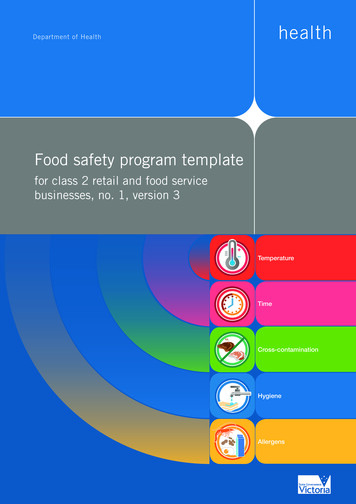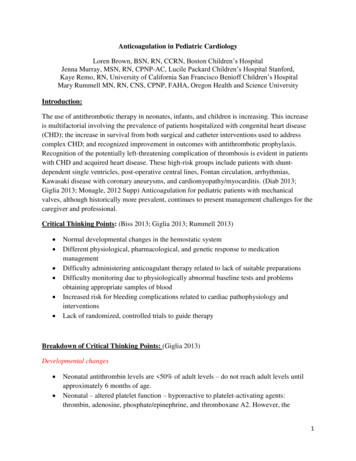
Transcription
HeartWare HVAD SystemPatient Manual
Quick Reference Guide for AlarmsWhen an alarm occurs, two lines of text appear in the Controller Display. The first linetells you what the alarm is, and the second line tells you what to do. The chart belowshows all potential alarms you may see on your controller.Alarm Type[No Power] AlarmHigh – Critical(Flashing Red)Medium(Flashing Yellow)Low(Solid Yellow)Alarm Display (Line 1)Action (Line 2)[no message][no message]When both power sources (2 batteries or 1 battery and anAC adapter or DC adapter) are removed, NO message will displayon the controller. The [No Power] alarm will sound but the AlarmIndicator on the controller WILL NOT light. This indicates your pumphas stopped. You should immediately connect two power sources.[VAD Stopped][Connect Driveline][VAD Stopped][Change Controller][Critical Battery][Replace Battery 1][Critical Battery][Replace Battery 2][Controller Failed][Change Controller][Controller Fault][Call][Controller Fault][Call: ALARMS OFF][High Watts][Call][Electrical Fault][Call][Low Flow][Call][Suction][Call][Low Battery 1][Replace Battery 1][Low Battery 2][Replace Battery 2][Power Disconnect][Reconnect Power 1][Power Disconnect][Reconnect Power 2]
Contact InformationAll problems should be promptly reported to your clinician. Before you leave the hospital,add names and contact information below. It is very important to keep this informationavailable in case something happens to you or to your HeartWare HVAD System.CLINICIAN mplanting HospitalNameAddressImplant Surgeon NamePhone NumberAMBULANCECompanyPhone Number
Introduction1Table of Contents1.0 Introduction. 11.1 Why You Should Read this Manual. 21.2 Heart Failure Overview. 21.3 Considering VAD Therapy. 31.4 Understanding How the HeartWare HVAD System Works. 31.5 Potential Complications and Risks. 41.6 Potential Benefits. 51.7 How to Decide if the HeartWare HVAD System is the RightTreatment for You. 51.8 Summary of Clinical Study Information Using the HeartWare HVAD System. 62.0 HeartWare HVAD System Overview. 72.1 Identifying the Components of the HeartWare HVAD System. 82.2Warnings andPrecautions. 112.3 Essential Performance. 162.4 The Operation to Place the HeartWare HVAD System. 173.0 Handling HeartWare HVAD System Components. 193.1 How the Controller Works. 203.2 Making Connections. 223.2.1 Driveline Connection. 223.2.2 Power Source Connections. 243.3 Changing Power Sources. 263.4 Using Battery Power. 273.5 Changing Battery. 293.6 Battery Charger. 303.7 Setting Up Your HeartWare HVAD System Carrying Cases. 333.8 How Long HeartWare HVAD System Equipment Should Last. 404.0 Emergencies and Alarms. 414.1 Handling an Emergency. 424.2 Overview of Alarms. 434.3 [No Power] Alarm. 444.4 High Alarms. 444.5 Medium Alarms. 454.6 Low Alarms. 464.7 Multiple Alarms. 464.8 How to Silence (Mute) Alarms. 474.9 Changing Controller to Back-Up Controller. 48
1IntroductionTable of Contents (continued)5.0 Preparing for Discharge. 535.1 Equipment Needed to Go Home. 545.2 Discharge Instructions. 545.3 Patient and Caregiver Training (No Answers). 57The test with answers is located in the Appendix6.0 Living with the HeartWare HVAD System. 636.1 Medications. 656.2 Understanding and Preventing Electrostatic Discharge (ESD). 656.3 Exit Site Care. 676.4 Washing and Showering. 686.5 Loading the Shower Bag. 696.6 Traveling and Transport. 727.0 Caring for HeartWare HVAD System Equipment. 737.1 General Care. 747.2 Care of Your Controller. 747.3 Care of Your Batteries. 757.4 Care of Your Battery Charger. 777.5 Care of Your Carry and Shower Bags. 778.1 Glossary of Terms. 809.0 Appendix. 839.1 Answers to Patient and Caregiver Training. 84 8.0 Glossary. 79
Introduction1Notes
HeartWare HVAD System1.0 Introduction1.1Why You Should Read this Manual.21.2Heart Failure Overview.21.3Considering VAD Therapy.31.4 Understanding How the HeartWare HVAD SystemWorks.3 1.5Potential Complications and Risks .41.6Potential Benefits.51.7 How to Decide if the HeartWare HVAD System isthe Right Treatment for You.51.8 Summary of Clinical Study InformationUsing the HeartWare HVAD System.61
1.0 Introduction1.1 Why You Should Read this ManualThis manual is intended for patients and caregivers. It will tell you about yourHeartWare HVAD System and explain how it works. It also provides informationabout proper care of the HeartWare HVAD System and what to do in case of anemergency.In addition to this manual, your clinician will provide you with instructions on operatingthe HeartWare HVAD System and on necessary medical care. Prior to leaving thehospital you should understand how the HeartWare HVAD System works, how tocare for the equipment and what to do in emergency situations. If you have anyquestions after reading this manual, please ask your clinician.WARNING! Please read this entire manual before using the HeartWare HVAD System outside of thehospital. It is not safe to use the system away from trained professionals until you understand theinformation in this manual.Symbols found in this manualIndicates there is moreinformation availablein the manual and willprovide details as towhere to find it.Identifies the informationas a Warning.A Warning is a statementabout the possibility ofinjury, death or other seriousadverse reaction thatis associated with the useor misuse of the device.Identifies the informationas a Caution.A Caution is a statementthat not followingthe instruction may leadto device misuse,malfunction or damage.Indicates there isan additional quickreference guideavailable fromyour clinician.1.2 Heart Failure OverviewIf you have been diagnosed with heart failure, it does not mean your heart hasstopped working; it means your heart is weak and as a result, cannot supply enoughoxygen and nutrient-rich blood to your body’s cells. Common symptoms of heartfailure include fatigue and shortness of breath. Everyday activities like walking,climbing stairs, or carrying groceries can become very difficult. Heart failure alsoaffects the kidneys’ ability to dispose of waste and extra fluid. Fluid retained by thekidneys increases swelling. Heart failure is generally a chronic, progressive conditionin which the heart weakens to the point in which it can no longer pump enoughblood to meet the body’s needs.2
HVAD Patient Manual1.3 Considering VAD TherapyA Ventricular Assist Device (VAD) is a mechanical pump. When one of the heart’snatural pumps (a ventricle) does not perform well, a VAD is used to increase theamount of blood that flows through the body.Clinicians use VADs such as the HeartWare HVAD System to treat patients withsevere heart failure who have not improved despite using all other treatmentmethods available. The HeartWare HVAD System can be used in patients both asa Bridge to Cardiac Transplantation and Destination Therapy.1.4 Understanding How the HeartWare HVAD System WorksThe HVAD Pump is surgically implanted in the chest, in a sac around the heartknown as the pericardial space. It is connected directly to your heart at the bottomof the left ventricle, where it draws oxygen-rich blood through the pump and pushesit into your aorta (large blood vessel that carries blood from your heart to the rest ofyour body). Your clinician will program the HVAD Pump so it delivers the rightamount of flow for your body’s needs. The driveline is connected to the pump andexits the body through a small incision in the skin. The driveline connects to thecontroller.The controller is a mini computer that monitors the HVAD Pump. It provides textmessages and audible alarms to help you manage the system. The controller is powered by two power sources: two rechargeable batteries, or one battery andelectricity from a wall or car outlet. The controller and batteries can be containedin a carrying case.Figure 1: HeartWare HVAD System3
1.0 Introduction1.5 Potential Complications and RisksThe HeartWare HVAD System has been studied in clinical trials and a variety ofpotential complications were identified. Many of these complications were wellknown from prior experience with other VADs. However it is important that youunderstand all of the potential complications that may occur with the HeartWare HVAD System.Talk to your clinician to understand your risks and potential complications ifimplanted with the HeartWare HVAD System, especially the risk of having a stroke.The risk of death as a result of stroke has been observed in randomized clinical trialsto be higher with the HVAD than with alternative treatment options. The overall rateof stroke was shown to be higher with the HVAD than with alternative treatmentoptions; however, one of the trials suggested that closely following a blood pressuretreatment plan as recommended by your physician may reduce your stroke risk.Please refer to Section 1.8, the Summary of Clinical Study Information, to learn moreabout strokes that have occurred in patients with an HVAD Pump. Complicationscan occur around the time of implant as well as any time while the system isproviding support.Implantation of any VAD is a major operation that may lead to serious complications.Complications associated with HearWare HVAD System use and the percentagesof patients who develop these complications are shown in the next table. It is possible that a complication not listed in this table may occur.WARNING! Serious and life threatening adverse events, especially stroke, have been associatedwith use of this device. The risk of death as a result of stroke has been observed in randomizedclinical trials to be higher with the HVAD than with alternative treatment options. The overall rateof stroke was shown in randomized clinical trials to be higher with the HVAD than with alternativetreatment options; however, one of the trials suggested that closely following a blood pressuretreatment plan as recommended by your physician may reduce your stroke risk. You must fullyconsider and discuss with your physician the risks of this device with that of other treatmentmodalities before deciding to proceed with device implantation.4
HVAD Patient Manual1.5 Potential Complications and Risks (continued)A list of possible complications is included below. Talk to your clinician to understandyour risks associated with both the implant surgery and HeartWare HVAD System use.Table 1: Complications that may occur with the HearWare HVAD SystemComplicationsInfectionKidney problemsBleedingLiver problemsIrregular Heart BeatDamage to the blood cellsFailure of the Right Side of the HeartHeartWare HVAD System malfunction orfailureLung ProblemsHigh blood pressureStrokeRe-operationPainDeathBlood clots1.6 Potential Benefits1.7 How to Decide if the HeartWare HVAD System is the RightTreatment for YouOnly you, in consultation with your clinicians can decide if having the HeartWare HVAD System is right for you. Your clinicians will talk with you about the potentialbenefits and risks of surgery and implantation of the HeartWare HVAD System. Besure to talk to your clinicians about any concerns or questions you may have.The HeartWare HVAD System should not be used if you cannot take blood thinningmedications.WARNING! DO NOT become pregnant while you have the HeartWare HVAD System. If you area woman of childbearing age, use birth control if you are sexually active. Blood thinners (whichmost VAD patients receive) have been associated with birth defects. If you do become pregnant, tell your clinician immediately.5 The HeartWare HVAD System was designed to assist a failing heart. The potentialbenefit of having the HearWare HVAD System is the relief of the symptoms ofadvanced heart failure while you are waiting for a heart transplant. As a result of therelief of symptoms of heart failure you will feel stronger and have the ability to bemore active. However, there is no guarantee of this and your symptoms may remainunchanged.
1.0 Introduction1.8 Summary of Clinical Study Information Using the HeartWare HVAD SystemThe HeartWare HVAD System has been evaluated in patients with advanced heartfailure in two clinical studies. The first clinical study was conducted in Europe andAustralia. This study included 50 patients of which 90% successfully reached the studysuccess point. The definition of success was: Being alive on the HeartWare HVAD System for 180 days or Receiving a heart transplant within 180 days of having the HVAD Pump implantedor Having the HVAD Pump successfully removed after the patient’s own heartrecovered within 180 days of HVAD Pump implant.A second, larger bridge to heart transplantation study was performed in theUnited States. This study included 140 patients. Of the 140 patients who receivedthe HeartWare HVAD System as a bridge to heart transplantation in the UnitedStates, 91% reached the study success point. In both these studies, there wereimprovements in the patients’ quality of life and their ability to better performphysical activities with at least 92% of the patients being able to return home afterthe HeartWare HVAD System was placed inside the body.The HeartWare HVAD System was evaluated as a destination therapy inpatients with advanced heart failure who are not on the list for a heart transplantin two additional clinical trials in the United States. These studies included over900 patients; 2/3 of the patients received the HeartWare HVAD System, andthe other 1/3 received a different pump already approved for destinationtherapy. The primary endpoint for the first clinical trial was being alive at 2 yearson support, without having experienced a severely disabling stroke or having toundergo urgent heart transplant or require surgery to change the heart pump fora new one due to problems with the original pump. A severely disabling strokeis a stroke that results in long-lasting, even permanent side effects that preventyou from being able to take care of yourself or perform everyday tasks withouthelp. The first trial showed that in patients with advanced heart failure who werenot on the list for a heart transplant, the HeartWare HVAD System had similarprimary outcomes as the other device available for destination therapy, andboth devices resulted in similar improvements in the patients’ quality of life andtheir ability to better perform physical activities. However, there were more overallstrokes in patients who received the HeartWare HVAD System, including morepatients who also died as a result of a stroke. The second clinical study showedthat managing patients’ blood pressure may reduce the risk of these strokes.T he risks identified in the clinical trials are described in Section 1.5,“Potential Complications and Risks”.6
HeartWare HVAD System2.0 HeartWare HVAD System Overview2.1 Identifying the Components of the HeartWare HVAD System.82.22.3Warnings andPrecautions. 11Essential Performance. 162.4 The Operation to Place the HeartWare HVAD System. 17WARNING! DO NOT use any components other than those supplied by HeartWarewith the HeartWare HVAD System, as this may affect HeartWare HVAD System operation.CAUTION: Use only HeartWare-supplied components with your HeartWare HVAD System.7
2.0 HeartWare HVAD System Overview2.1 Identifying the Components of the HeartWare HVAD SystemHVAD Pump and DrivelineThe HVAD Pump is small and has one moving part, called an impeller (Figure 2).As the impeller spins it moves blood from the heart to the body. The amount ofblood flowing through your pump depends on the speed of the impeller and yourblood pressure. The driveline passes through your skin and connects the pump tothe controller.Figure 2 Driveline CoverThe driveline cover (Figure 3) should always cover the silverdriveline connector unless an emergency controller exchangeis required. With proper driveline cover position you shouldNOT see the silver driveline connector.Figure 3HVAD ControllerThe controller (Figure 4) operates your pump and makes surethat it is working correctly. The controller is connected to yourdriveline and should have two power sources (batteries, ACadapter or DC adapter) connected at all times. The displayFigure 4on the controller gives information about pump performancethat includes the blood flow through the pump (L/min), impellerspeed (RPM) and the amount of power consumed (Watts). Thecontroller also warns you if there is a problem with your pump orwith the power supplies connected to your controller.Additional information about your pump operation is stored inyour controller and may be used by your clinician.Caution: Tell your clinician if you have sight or hearing problems. The controller uses words, lightsand sounds to tell you how the system is operating and when to seek additional help.For additional information on how the controller works, see Section 3.1.8
HVAD Patient Manual2.1 I dentifying the Components of the HeartWare HVAD System(continued)Red Alarm AdapterThe red alarm adapter (Figure 5) is for emergency use only.The adapter is used to silence the [No Power] alarm whenpower is removed from a controller that is no longer in use.Figure 5HeartWare HVAD System Power SourcesSince the controller requires two power sources for safety: either two batteries(Figure 6), or one battery and an AC adapter (Figure 7) or DC adapter (Figure 8)must be connected. While active, you will typically use two batteries. While relaxingor sleeping, you should use power from an electrical outlet (AC adapter) becauseit provides power for an unlimited period of time.Figure 6: BatteryFigure 7: AC AdapterFigure 8: DC Adapter WARNING! ALWAYS connect an AC Adapter to the controller before relaxing or sleeping. Powerfrom an electrical outlet (AC Adapter) provides power for an unlimited period of time.For additional information on HeartWare HVAD System Power Sources,see Sections 3.2, 3.3, 3.4 and 3.5.HeartWare Battery ChargerThe battery charger is used to charge up to 4 batteries ata time. It takes about 5 to 6 hours to fully charge a battery.Each battery slides into a slot and the battery is connectedto the battery charger. When not in use, you can safelyleave the battery connected to the charger.Figure 9For additional information on how the HeartWare Battery Charger works, see Section 3.6.9
2.0 HeartWare HVAD System Overview2.1 Identifying the Components of the HeartWare HVAD System(continued)HeartWare Waist PackThe HeartWare Waist Pack is designed to hold the controllerand two batteries around the waist. The waist pack comes witha support strap to help in putting on or taking off the pack,and a belt extender to make the waist pack belt bigger.A viewing window allows the patient to see the controllerdisplay. Magnetic snaps keep the equipment pocketsclosed and allow easy access.Figure 10HeartWare Shoulder PackThe HeartWare Shoulder Pack holds the controller andtwo batteries in a shoulder bag. A viewing window allows youto see the Controller Display. Magnetic snaps keep the bagclosed and allow easy access. The shoulder pack can beattached to the waist belt for additional support if desired. Abelt extender is included to make the belt bigger if necessary.Figure 11HeartWare Convertible Patient PackThe HeartWare Convertible Patient Pack holds the controllerand two batteries for daily use. A viewing window allowsyou to see the Controller Display. Velcro strips keep the bagclosed and the accessories securely fastened. It can be wornover the shoulder, around the waist or a combination of both.Figure 12For additional information on carrying cases, see Section 3.7.HeartWare Shower BagThe HeartWare Shower Bag provides the ability to comfortablyand securely shower with your HeartWare HVAD System.The shower bag is water resistant, not water proof, andprotects the controller and batteries from direct water sprayand moisture. The shower bag permits one (1) controller andtwo (2) batteries to be placed into a single compartment.Figure 13For additional information on using the shower bag, see Section 6.5.10
HVAD Patient Manual2.2 Warnings and PrecautionsThis section explains safety-related information related to the proper handling of theHeartWare HVAD System. Read these passages carefully.WARNINGSA Warning is a statement about the possibility of injury, death or other seriousadverse reaction associated with the use or misuse of the device.1. W ARNING! Serious and life threatening adverse events, especially stroke, havebeen associated with use of this device. The risk of death as a result of strokehas been observed in randomized clinical trials to be higher with the HVADthan with alternative treatment options. The overall rate of stroke was shownin randomized clinical trials to be higher with the HVAD than with alternativetreatment options; however, one of the trials suggested that closely followinga blood pressure treatment plan as recommended by your physician mayreduce your stroke risk. You must fully consider and discuss with your physicianthe risks of this device with that of other treatment modalities before decidingto proceed with device implantation.2. W ARNING! Please read this entire manual before using the HeartWare HVAD System outside of the hospital. It is not safe to use the system away from trainedprofessionals until you understand the information in this manual.3. W ARNING! DO NOT become pregnant while you have the HeartWare HVAD System. If you are a woman of childbearing age, use birth control if you aresexually active. Blood thinners (which most VAD patients receive) have beenassociated with birth defects. If you do become pregnant, tell your clinicianimmediately. 4. W ARNING! DO NOT use any components other than those supplied by HeartWarewith the HeartWare HVAD System, as this may affect HeartWare HVAD System operation.5. WARNING! ALWAYS connect an AC Adapter to the controller before relaxing orsleeping. Power from an electrical outlet (AC Adapter) provides power for anunlimited period of time.6. W ARNING! DO NOT operate the controller in temperatures less than -20 C (-4 F)or greater than 50 C ( 122 F) or the controller may fail.7. WARNING! DO NOT disconnect the driveline from the controller or the pumpwill stop. If this happens, reconnect the driveline to the controller as soon aspossible to restart the pump.8. W ARNING! DO NOT attach the alarm adapter to a controller that is connectedto a running pump. The alarm adapter silences the [No Power] alarm andshould only be attached to a controller that has failed or malfunctioned andis no longer connected to a pump.9. W ARNING! ALWAYS keep a spare controller and fully charged spare batteriesavailable at all times in case of an emergency.10. WARNING! ALWAYS replace a controller if it has a blank display and/or noaudible alarms. 11
2.0 HeartWare HVAD System Overview2.2 Warnings and Precautions (continued)WARNINGS continued11. WARNING! ALWAYS switch to the back-up controller if there is a [ControllerFailed] alarm.12. WARNING! ALWAYS respond to low battery alarms. Silencing an alarm does notresolve the alarm condition and will eventually deplete the batteries.13. WARNING! NEVER disconnect both power sources (batteries, AC adapter,DC adapter) at the same time since this will stop the pump and activate the[No Power] alarm. At least one power source must be connected at all times.14. WARNING! DO NOT plug the HeartWare Battery Charger AC adapter into anelectrical outlet which is not properly grounded or you may receive a seriouselectrical shock.15. WARNING! ALWAYS investigate, and if possible, correct the cause of anyalarm. Silencing an alarm does not resolve the alarm condition.16. WARNING! ALWAYS check the Controller Display for any information regardingan alarm when using loud machinery or in the vicinity of loud noises sinceunder these conditions, the controller and battery alarms may not be audible.17. WARNING! DO NOT have a magnetic resonance imaging (MRI) procedurewhile implanted with the HeartWare HVAD System. Doing so could harm youor cause the pump to stop.18. WARNING! Keep mobile phones at least 20 inches (50 centimeters) away fromthe controller, as mobile phones may interfere with controller operation.19. WARNING! DO NOT undergo procedures requiring
Implantation of any VAD is a major operation that may lead to serious complications. Complications associated with HearWare HVAD System use and the percentages of patients who develop these complications are shown in the next table. It is possi-ble that a complication not listed in this table may occur. WARNINg!










